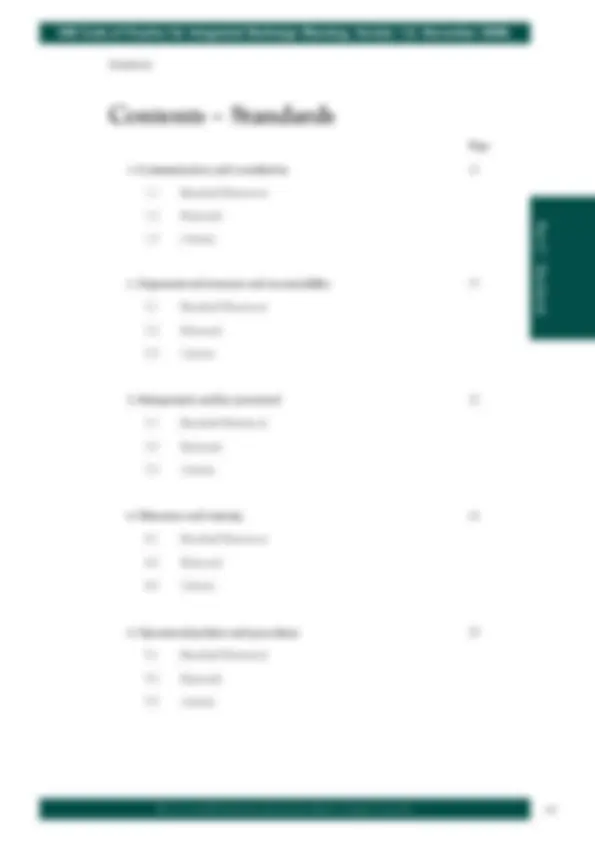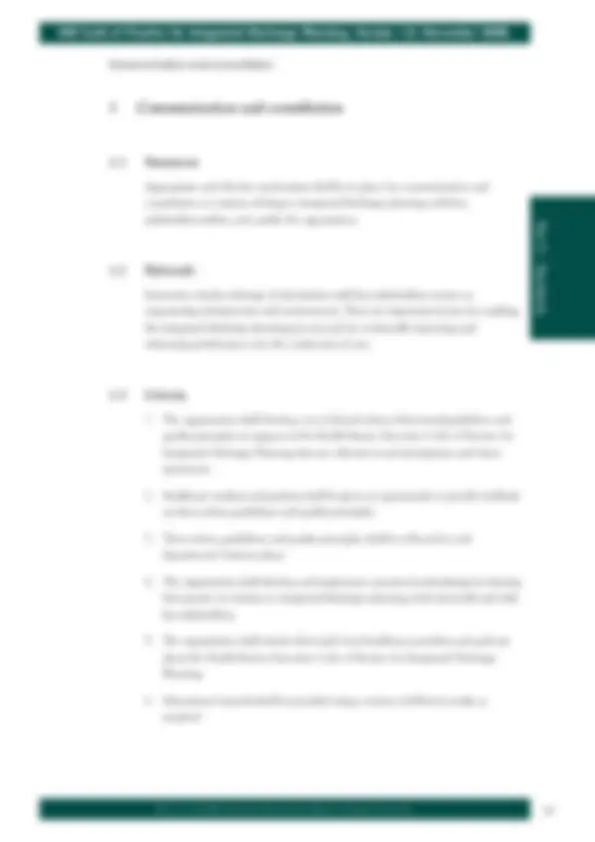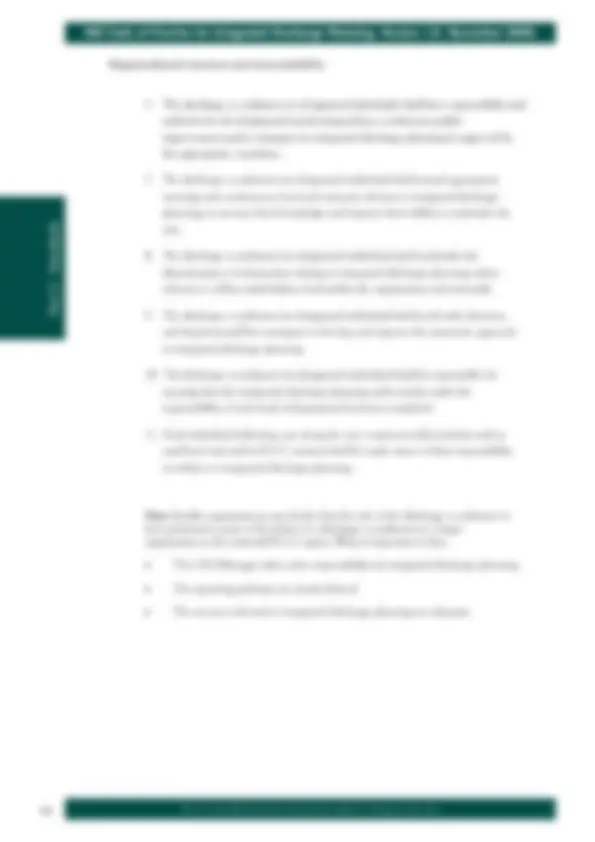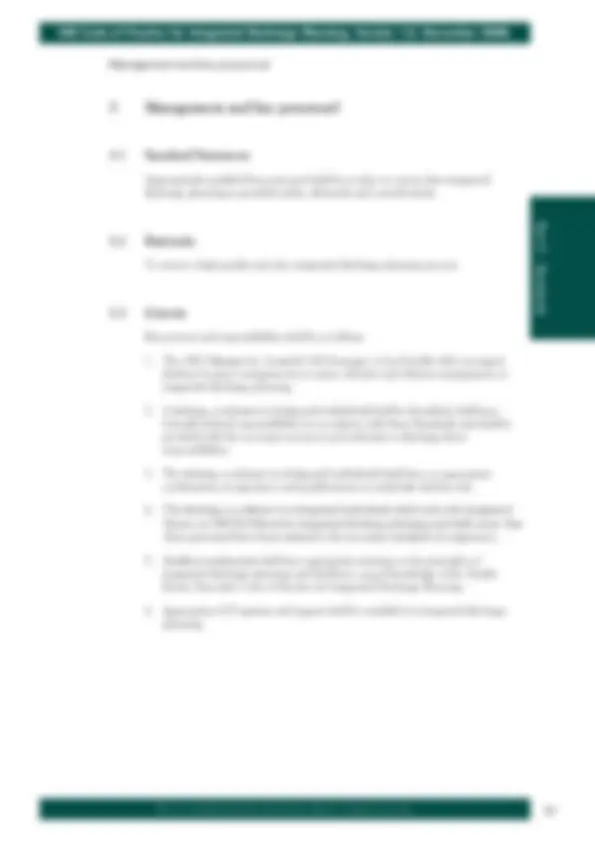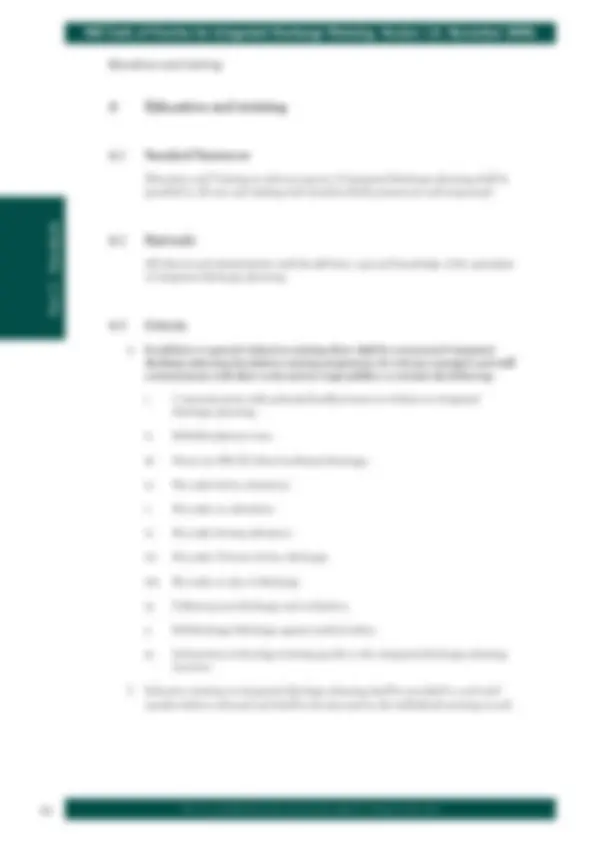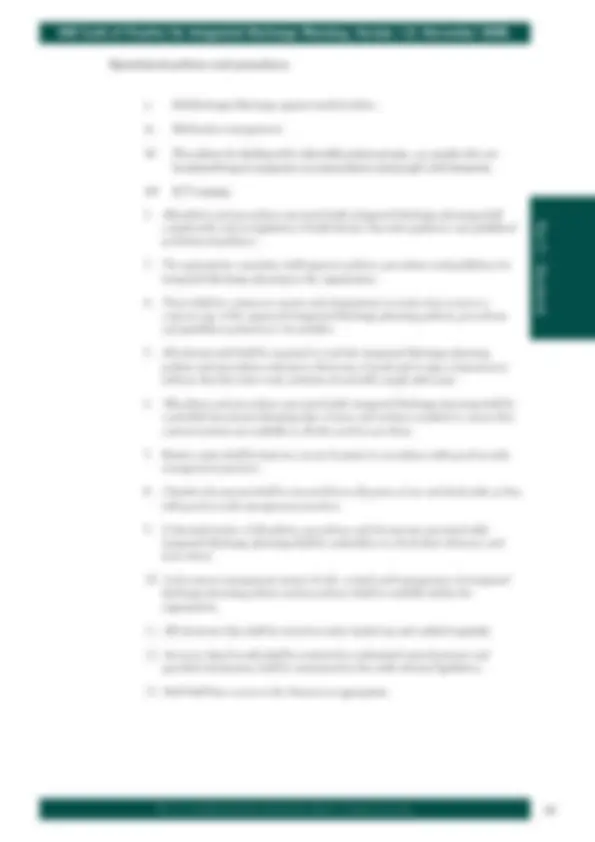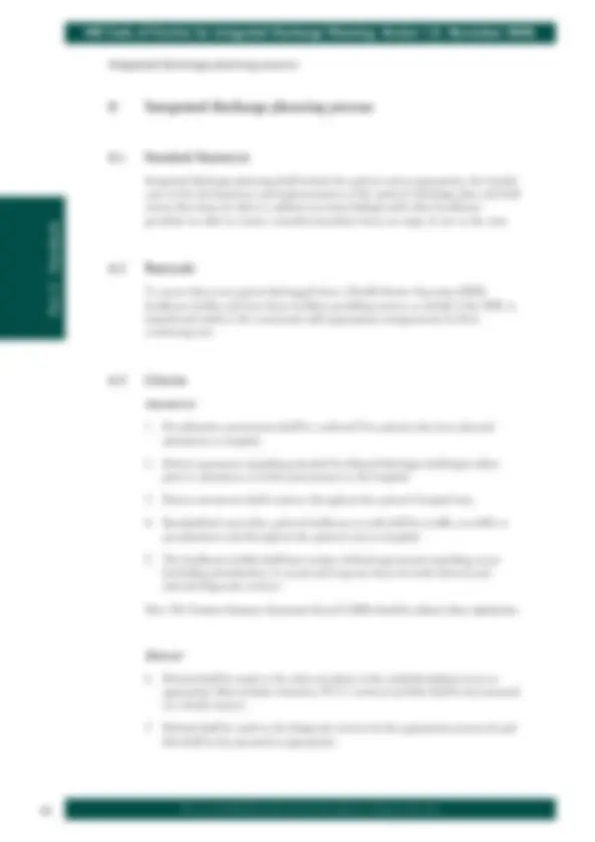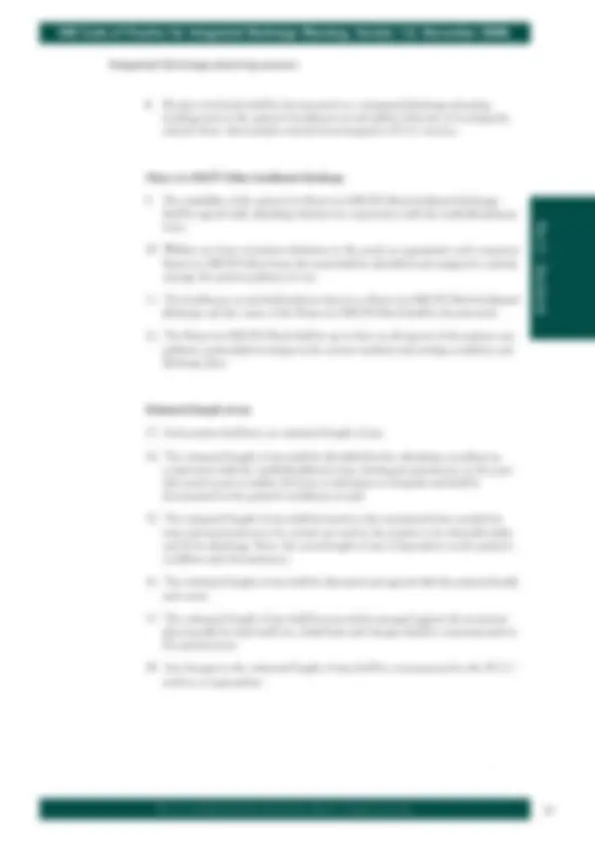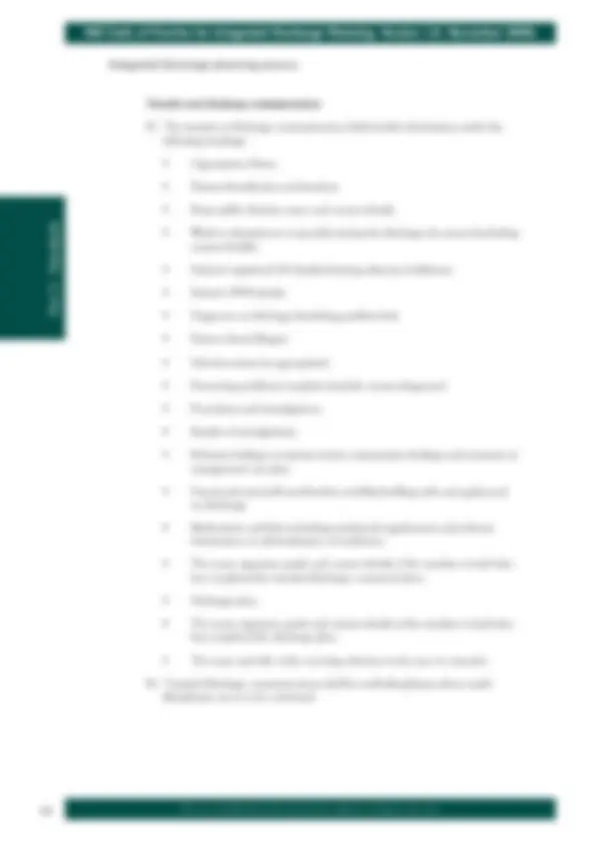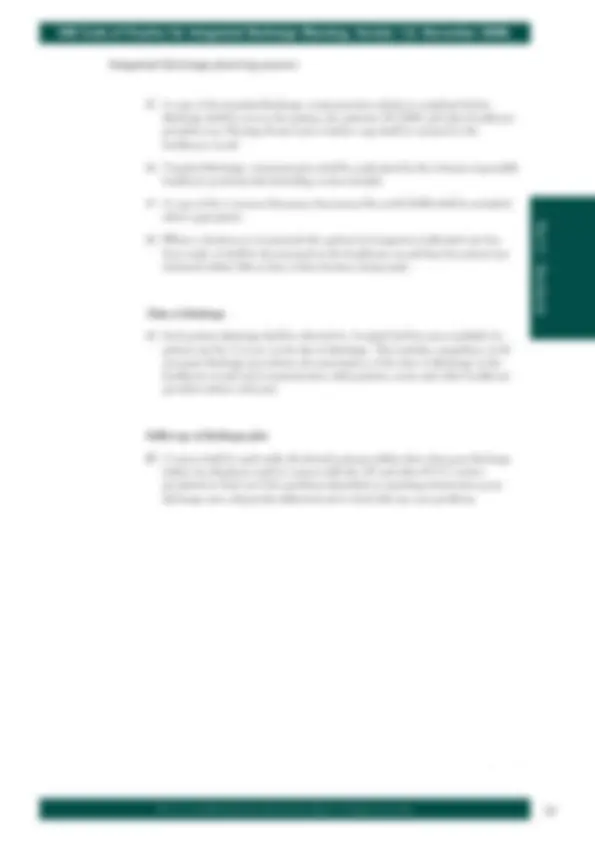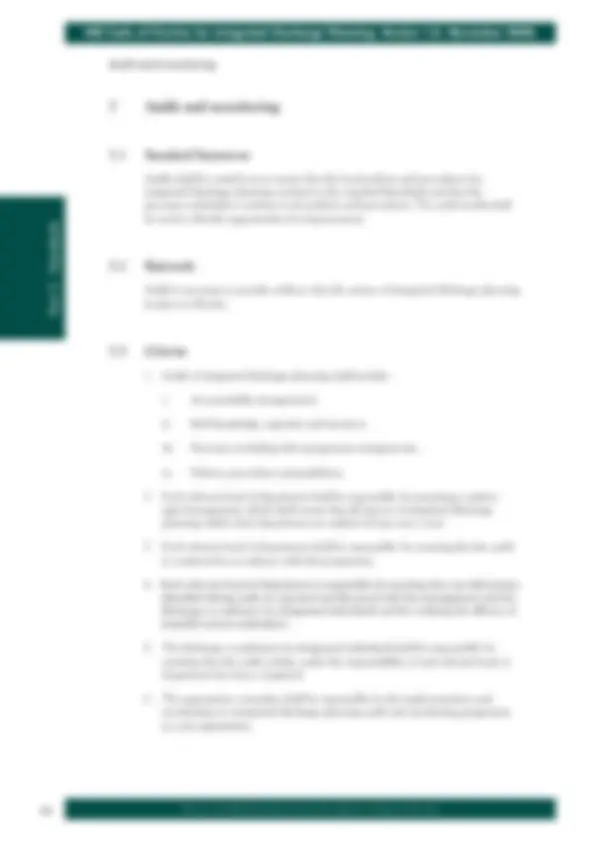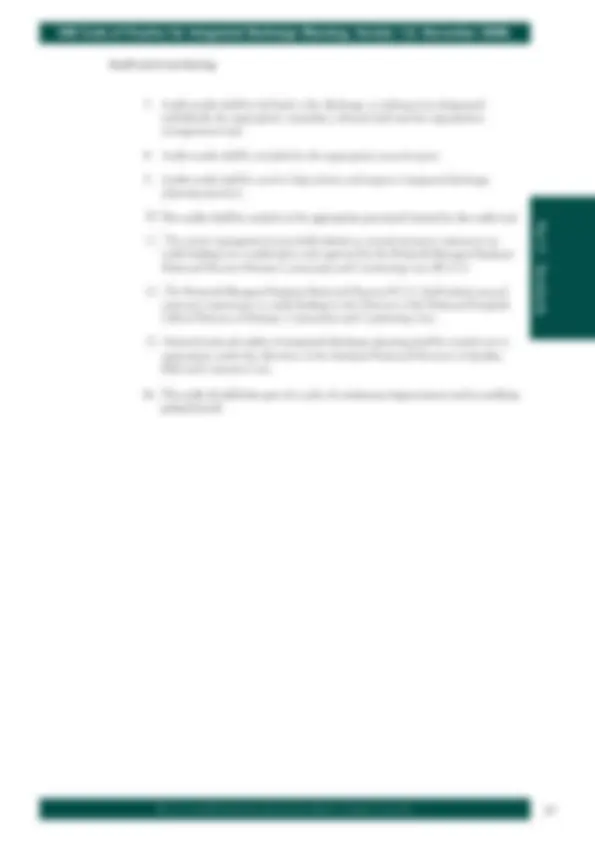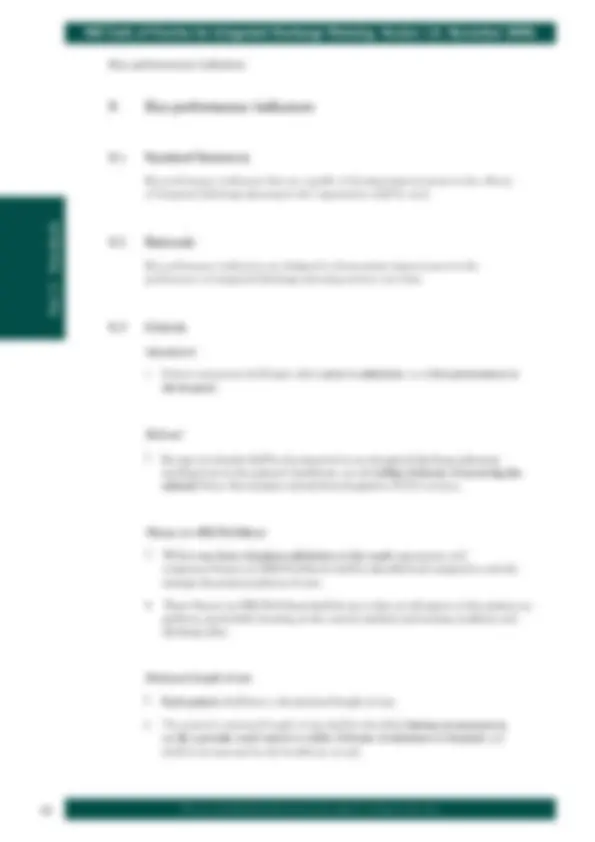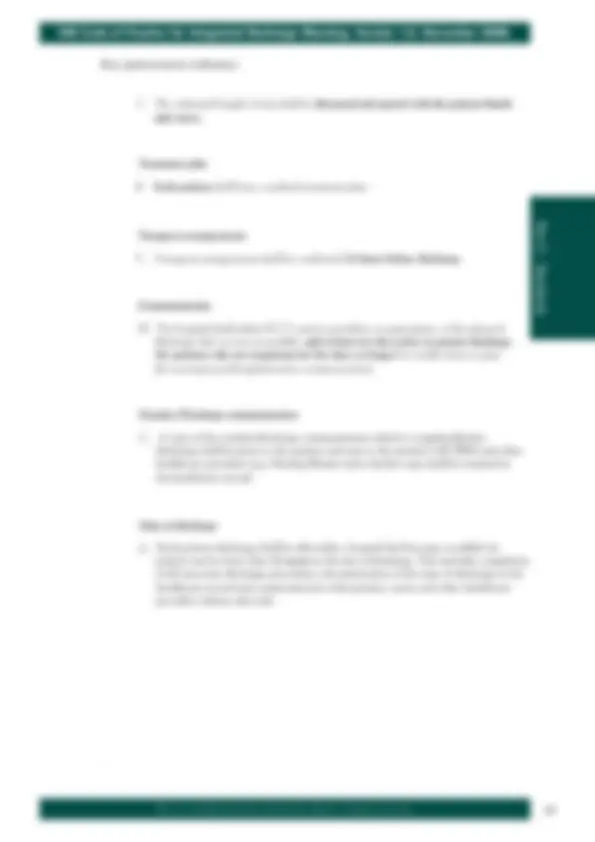Download Integrated Discharge Planning: Best Practices and Implementation and more Schemes and Mind Maps Communication in PDF only on Docsity!
Health Service Executive
Code of Practice for
Integrated Discharge Planning
Part 2: Standards
17
This is a controlled document and may be subject to change at any time.
Page 3
Part 2
Part 2
Standards
Part 2 - Standards
HSE Code of Practice for Integrated Discharge Planning. Version 1.0. November 2008.
18 This is a controlled document and may be subject to change at any time.
This is a controlled document and may be subject to change at any time.
Page 5
Contents
Page
6. Integrated discharge planning process 15
6.1 Standard Statement
6.2 Rationale
6.3 Criteria
7. Audit and monitoring 21
7.1 Standard Statement
7.2 Rationale
7.3 Criteria
8. Key performance indicators 23
8.1 Standard Statement
8.2 Rationale
8.3 Criteria
Part 2 - Standards
HSE Code of Practice for Integrated Discharge Planning. Version 1.0. November 2008.
20 This is a controlled document and may be subject to change at any time.
30
36
38
This is a controlled document and may be subject to change at any time.
Page 6
Communication and consultation
1 Communication and consultation
1.1 Statement
Appropriate and effective mechanisms shall be in place for communication and consultation on matters relating to integrated discharge planning, with key stakeholders within and outside the organisation.
1.2 Rationale
Interactive, timely exchange of information with key stakeholders creates an empowering infrastructure and environment. These are important factors for enabling the integrated discharge planning process and for continually improving and enhancing performance over the continuum of care.
1.3 Criteria
- The organisation shall develop a set of shared values, behavioural guidelines and quality principles in support of the Health Service Executive Code of Practice for Integrated Discharge Planning that are reflected in job descriptions and vision statements.
- Healthcare workers and patients shall be given an opportunity to provide feedback on these values, guidelines and quality principles.
- These values, guidelines and quality principles shall be reflected in each departments’ business plans.
- The organisation shall develop and implement a practical methodology for sharing best practice in relation to integrated discharge planning, both internally and with key stakeholders.
- The organisation shall inform their staff, local healthcare providers and patients about the Health Service Executive Code of Practice for Integrated Discharge Planning.
- Educational material shall be provided using a variety of different media as required.
Part 2 - Standards
HSE Code of Practice for Integrated Discharge Planning. Version 1.0. November 2008.
This is a controlled document and may be subject to change at any time. (^21)
This is a controlled document and may be subject to change at any time.
Page 8
Organisational structure and accountability
2 Organisational structure and accountability
2.1 Standard Statement
Responsibility for integrated discharge planning shall be clearly defined and there shall be clear lines of accountability throughout the organisation.
2.2 Rationale
The CEO/Manager (i.e. hospital CEO/manager or local health office manager) through the senior management team, is responsible for ensuring that there are effective arrangements for integrated discharge planning.
2.3 Criteria
- Individual responsibility for integrated discharge planning shall be defined throughout the organisation and there shall be clear lines of accountability leading up to the most senior manager of the organisation.
- The scope of responsibility shall include the competence of contractors where the organisation buys in services and professional liability where the organisation buys in or sells services to other organisations.
- Integrated discharge planning shall be a standard item on the agenda of the appropriate committee in the organisation. The Discharge Co-ordinator (or designated individual) shall submit regular reports on management of integrated discharge planning to the committee.
- A monthly report on the effectiveness of integrated discharge planning shall be submitted to the appropriate committee for review. This committee, which shall include in its membership the CEO/Manager or CEO/Manager nominee, shall present the report (with suggestions, where appropriate) to the management team.
- Each organisation shall identify a discharge co-ordinator (or designated manager... see note overleaf ). The duties of the designated person shall not be confined to any one aspect of the integrated discharge planning function but shall encompass all integrated discharge planning processes wherever they occur within the organisation.
Part 2 - Standards
HSE Code of Practice for Integrated Discharge Planning. Version 1.0. November 2008.
This is a controlled document and may be subject to change at any time. (^23)
- Each organisation shall identify discharge co-ordinators (or a designated manager... see note overleaf ). The duties of the designated person shall not be confined to any one aspect of the integrated discharge planning function but shall encompass all integrated discharge planning processes wherever they occur within the organisation.
This is a controlled document and may be subject to change at any time.
Page 9
Organisational structure and accountability
- The discharge co-ordinator (or designated individual) shall have responsibility and authority for developing and monitoring policies, continuous quality improvement and/or strategies for integrated discharge planning for approval by the or appropriate committee.
- The discharge co-ordinator (or designated individual) shall attend appropriate meetings and conferences, local and national, relevant to integrated discharge planning, to increase their knowledge and improve their ability to undertake the role.
- The discharge co-ordinator (or designated individual) shall undertake the dissemination of information relating to integrated discharge planning, where relevant, to all key stakeholders, both within the organisation and externally.
- The discharge co-ordinator (or designated individual) shall work with clinicians and departmental/line managers to develop and improve the systematic approach to integrated discharge planning.
- The discharge co-ordinator (or designated individual) shall be responsible for ensuring that the integrated discharge planning audit activity under the responsibility of each head of department has been completed.
- Each individual delivering care along the care continuum (this includes staff at ward level and staff in PCCC services) shall be made aware of their responsibility in relation to integrated discharge planning.
Note: Smaller organisations may decide that the role of the discharge co-ordinator is best performed as part of the duties of a discharge co-ordinator in a larger organisation in the network/PCCC region. What is important is that:
x The CEO/Manager takes active responsibility for integrated discharge planning.
x The reporting pathways are clearly defined.
x The resources devoted to integrated discharge planning are adequate.
Part 2 - Standards
HSE Code of Practice for Integrated Discharge Planning. Version 1.0. November 2008.
24 This is a controlled document and may be subject to change at any time.
7KH GLVFKDUJH FR�RUGLQDWRU RU GHVLJQDWHG LQGLYLGXDO VKDOO KDYH UHVSRQVLELOLW\ DQG
DXWKRULW\ IRU GHYHORSLQJ DQG PRQLWRULQJ SROLFLHV� FRQWLQXRXV TXDOLW\
LPSURYHPHQW DQG�RU VWUDWHJLHV IRU LQWHJUDWHG GLVFKDUJH SODQQLQJ IRU DSSURYDO E\
WKH DSSURSULDWH FRPPLWWHH�
This is a controlled document and may be subject to change at any time.
Page 11
Education and training
4 Education and training
4.1 Standard Statement
Education and Training in relevant aspects of integrated discharge planning shall be provided to all new and existing staff members (both permanent and temporary).
4.2 Rationale
All clinical and administrative staff should have a general knowledge of the principles of integrated discharge planning.
4.3 Criteria
1. In addition to general induction training there shall be a structured integrated discharge planning foundation training programme for relevant managers and staff commensurate with their work activity/responsibility to include the following:
i. Communication with patients/families/carers in relation to integrated discharge planning.
ii. Multidisciplinary team.
iii. Nurse (or HSCP/Other) facilitated discharge.
iv. Key tasks before admission.
v. Key tasks on admission.
vi. Key tasks during admission.
vii. Key tasks 24 hours before discharge.
viii. Key tasks on day of discharge.
ix. Follow-up post discharge and evaluation.
x. Self-discharge/discharge against medical advice.
xi. Information technology training specific to the integrated discharge planning function.
- Induction training in integrated discharge planning shall be provided to each staff member (where relevant) and shall be documented in the individuals training record.
Part 2 - Standards
HSE Code of Practice for Integrated Discharge Planning. Version 1.0. November 2008.
26 This is a controlled document and may be subject to change at any time.
This is a controlled document and may be subject to change at any time.
Page 12
Education and training
- Staff from acute and PCCC services shall participate in joint training sessions. Such sessions shall have a common focus and shall include a focus on person centred care across the continuum of care.
- Acute and PCCC services shall work in partnership to provide training opportunities which shall increase staff understanding of the role that their services play in the continuum of care, and the skills required.
- There shall be a continuing programme of training (internal organisation training on HSE Code of Practice for Integrated Discharge Planning) and education (external professional education) for staff on integrated discharge planning. Departmental records of staff attendance at further training in integrated discharge planning shall be kept.
- Training shall be supported with adequate resources and facilities.
- Competencies in integrated discharge planning across the organisation shall be assessed and records shall be kept.
- A formal appraisal system shall be in place to monitor staff performance and to identify individual training needs.
- The organisation shall undertake an annual training needs analysis for integrated discharge planning and shall develop a training plan to support the needs identified.
Note: Integrated discharge planning principles and processes shall be incorporated into undergraduate and postgraduate clinical education for all disciplines.
Part 2 - Standards
HSE Code of Practice for Integrated Discharge Planning. Version 1.0. November 2008.
This is a controlled document and may be subject to change at any time. (^27)
This is a controlled document and may be subject to change at any time.
Page 14
Operational policies and procedures
x. Self-discharge/discharge against medical advice.
xi. Medication management.
xii. Procedures with dealing for vulnerable patient groups, e.g. people who are homeless/living in temporary accommodation and people with dementia.
xiii. IT training.
- All policies and procedures associated with integrated discharge planning shall comply with current legislation, Health Service Executive guidance and published professional guidance.
- The appropriate committee shall approve policies, procedures and guidelines for integrated discharge planning in the organisation.
- There shall be a system to ensure each department or service has access to a current copy of the approved integrated discharge planning policies, procedures and guidelines pertinent to its activities.
- All relevant staff shall be required to read the integrated discharge planning policies and procedures relevant to their area of work and to sign a statement to indicate that they have read, understood and will comply with same.
- All policies and procedures associated with integrated discharge planning shall be controlled documents (showing date of issue and revision number) to ensure that current versions are available to all who need to use them.
- Master copies shall be kept in a secure location in accordance with good records management practices.
- Obsolete documents shall be removed from all points of use and dealt with, in line with good records management practices.
- A biennial review of all policies, procedures and documents associated with integrated discharge planning shall be undertaken to check their relevance and issue status.
- A document management system for the control and management of integrated discharge planning policies and procedures shall be available within the organisation.
- All electronic data shall be stored securely, backed up and audited regularly.
- Access to data/records shall be restricted to authorised named persons and specified information shall be maintained in line with relevant legislation.
- Staff shall have access to the Intranet as appropriate.
Part 2 - Standards
HSE Code of Practice for Integrated Discharge Planning. Version 1.0. November 2008.
This is a controlled document and may be subject to change at any time. (^29)
x. Self-discharge/discharge against medical advice.
xi. Medication management.
xii. Procedures for dealing with vulnerable patient groups, e.g. people who are homeless/living in temporary accommodation and people with dementia.
xiii. ICT training.
This is a controlled document and may be subject to change at any time.
Page 15
Integrated discharge planning process
6 Integrated discharge planning process
6.1 Standard Statement
Integrated discharge planning shall include the patient and as appropriate, the family/ carer in the development and implementation of the patient’s discharge plan and shall ensure that steps are taken to address necessary linkages with other healthcare providers in order to ensure a seamless transition from one stage of care to the next.
6.2 Rationale
To ensure that every patient discharged from a Health Service Executive (HSE) healthcare facility and from those facilities providing services on behalf of the HSE, is transitioned safely to the community with appropriate arrangements for their continuing care.
6.3 Criteria
Assessment
- Pre-admission assessments shall be conducted for patients who have planned admissions to hospital.
- Patient assessment regarding potential for delayed discharge shall begin either prior to admission or at first presentation to the hospital.
- Patient assessment shall continue throughout the patient’s hospital stay.
- Standardised, up-to-date, patient healthcare records shall be readily accessible at pre-admission and throughout the patient’s stay in hospital.
- The healthcare facility shall have in place defined agreements regarding access (including prioritisation of access) and response times for both internal and external diagnostic services.
Note: The Common Summary Assessment Record (CSAR) should be utilised, where appropriate.
Referral
- Referral shall be made to the other members of the multi-disciplinary team as appropriate (this includes referral to PCCC services) and this shall be documented in a timely manner.
- Referral shall be made to the diagnostic services by the appropriate personnel and this shall be documented as appropriate.
Part 2 - Standards
HSE Code of Practice for Integrated Discharge Planning. Version 1.0. November 2008.
30 This is a controlled document and may be subject to change at any time.
This is a controlled document and may be subject to change at any time.
Page 17
Integrated discharge planning process
Treatment plan
- Each patient shall have a medical treatment plan.
- The medical treatment plan shall be discussed and agreed with the patient/family and carers.
- The medical treatment plan shall be documented in the patient’s healthcare record.
Discharge plan
- Integrated discharge planning shall commence at pre-admission or on admission and shall include information about the patients’ pre-admission abilities in relation to potential discharge issues.
Transport arrangements
- Transport arrangements shall be confirmed 24 hours before discharge.
Communication
- Peri-operative services or pre-admission clinics shall communicate planned admissions to PCCC service providers before admission.
- The hospital shall notify PCCC service providers of unplanned admissions at the time of hospitalisation, as appropriate.
- When aware of a patient’s admission, PCCC service providers shall contact the hospital department ( as appropriate) to discuss premorbid health status to ensure continuity of care while the patient is in hospital.
- The hospital shall advise PCCC service providers, as appropriate, of the planned discharge date as soon as possible, and at least two days prior to patient discharge (for patients who are in-patients for five days or longer) to enable them to plan the necessary post-hospital service commencement.
- Two-way communication between the hospital and the GP and other PCCC service providers, as appropriate, shall be arranged to ensure such services are available and in place for the patient to use when needed post discharge.
- The discharge check list shall be completed twenty four hours before discharge to ensure all of the above activities have been carried out.
- The family/carers, GP and other PCCC service providers shall be contacted at least the day before discharge to confirm that the patient is being discharged and to ensure that services are activated or re-activated, as appropriate.
Part 2 - Standards
HSE Code of Practice for Integrated Discharge Planning. Version 1.0. November 2008.
32 This is a controlled document and may be subject to change at any time.
This is a controlled document and may be subject to change at any time.
Page 18
Integrated discharge planning process
- At the time of leaving the hospital, each patient shall be provided with an information pack containing relevant information such as patient/carer plan, a medication record, and information.
- Information and education shall be provided to the patient and the family/carer in the appropriate language, verbally and in written form relating to:
i. The anticipated course of treatment and estimated length of stay.
ii. Ongoing health management.
iii. An appropriate post-discharge contact to answer queries and address concerns.
iv. Medications.
v. The use of aids and equipment.
vi. Follow-up appointments.
vii. PCCC based service appointments.
viii. Possible complications and warning signs.
ix. When normal activities can be resumed.
Part 2 - Standards
HSE Code of Practice for Integrated Discharge Planning. Version 1.0. November 2008.
This is a controlled document and may be subject to change at any time. (^33)
This is a controlled document and may be subject to change at any time.
Page 20
Integrated discharge planning process
35. A copy of the transfer/discharge communication which is completed before discharge shall be sent to the patient, the patients GP, PHN and other healthcare providers (e.g. Nursing Home) and a further copy shall be retained in the healthcare record. 36. Transfer/discharge communication shall be authorised by the relevant responsible healthcare professionals (including contact details). 37. A copy of the Common Summary Assessment Record (CSAR) shall be included, where appropriate. 38. Where a decision to recommend the patient for long-term residential care has been made, it shall be documented in the healthcare record that the patient was informed within fifteen days of that decision being made.
Time of discharge
39. Each patient discharge shall be effected (i.e. hospital bed becomes available for patient use) by 12 noon on the day of discharge. This includes completion of all necessary discharge procedures, documentation of the time of discharge in the healthcare record and communication with patients, carers and other healthcare providers (where relevant).
Follow-up of discharge plan
- Contact shall be made with all referred patients within three days post discharge (either via telephone and/or contact with the GP and other PCCC service providers) to find out if the problems identified as requiring intervention post- discharge were adequately addressed and to deal with any new problems.
Part 2 - Standards
HSE Code of Practice for Integrated Discharge Planning. Version 1.0. November 2008.
This is a controlled document and may be subject to change at any time. (^35)
This is a controlled document and may be subject to change at any time.
Page 21
Audit and monitoring
7 Audit and monitoring
7.1 Standard Statement
Audits shall be carried out to ensure that the local policies and procedures for integrated discharge planning conform to the required Standards and that the processes undertaken conform to the policies and procedures. The audit results shall be used to identify opportunities for improvement.
7.2 Rationale
Audit is necessary to provide evidence that the system of integrated discharge planning in place is effective.
7.3 Criteria
- Audit of integrated discharge planning shall include:
i. Accountability arrangements.
ii. Staff knowledge, expertise and resources.
iii. Processes, including risk management arrangements.
iv. Policies, procedures and guidelines.
- Each relevant head of department shall be responsible for preparing a written agreed programme which shall ensure that all aspects of integrated discharge planning within their department are audited at least once a year.
- Each relevant head of department shall be responsible for ensuring that the audit is conducted in accordance with this programme.
- Each relevant head of department is responsible for ensuring that any deficiencies identified during audit are reported and discussed with line management [and the discharge co-ordinator (or designated individual)] and for verifying the efficacy of remedial actions undertaken.
- The discharge co-ordinator (or designated individual) shall be responsible for ensuring that the audit activity, under the responsibility of each relevant head of department has been completed.
- The appropriate committee shall be responsible for the implementation and monitoring of a integrated discharge planning audit and monitoring programme in each organisation.
Part 2 - Standards
HSE Code of Practice for Integrated Discharge Planning. Version 1.0. November 2008.
36 This is a controlled document and may be subject to change at any time.
- Each relevant head of department is responsible for ensuring that any deficiencies identified during audit are reported and discussed with line management and the discharge co-ordinator (or designated individual) and for verifying the efficacy of remedial actions undertaken.

